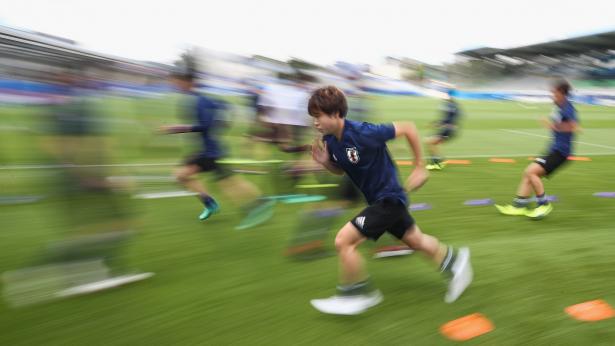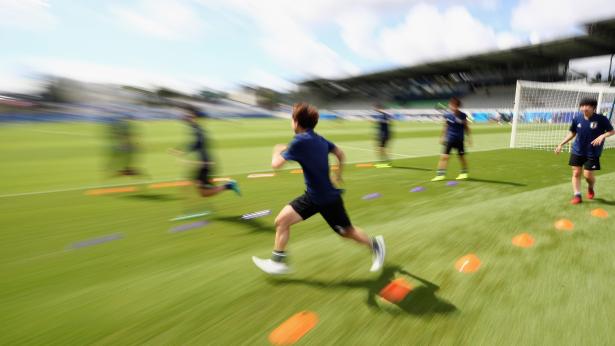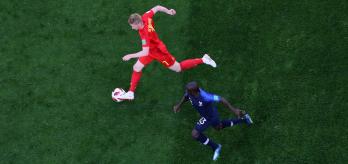Framework
Tactical awareness could be defined as "individual and collective game intelligence – the defensively agile and offensively audacious football mind". There are many components that go hand in hand to develop comprehensive tactical awareness, one of which is the focus of our first article: the spark for a player's quickness – alertness and anticipation.
Having a sense of alertness and anticipation, being on the front foot, prepared for action at any moment requires very high levels of concentration, especially in certain moments or situations of a game. For example, being ready and alert to press as part of a pack, or when players are fatigued and things are going against them. This spark of thought and movement quality in a footballer's armoury is essential when on the cusp of receiving a pass. It can give a player that split second to get to a ball first, enabling them to be one step ahead of the game, instead of reacting to in-match situations and opportunities slightly behind the required tempo.
Example
Our first piece of video footage of the series is from a FIFA U-20 Women’s World Cup™ match, Japan v. Paraguay, which gives us a vivid example of alertness and anticipation having an instant, decisive effect on game tempo and outcome.
The Japan player gives us a little glimpse of many receiving qualities, but focusing on the main topic of this article, let's highlight the immense part her anticipation and alertness played in the outcome.
- Anticipation and alertness got her a technical advantage by enabling her to reach the ball first. She was first to see and react to the situation, but turning a difficult ball reception into an unexpected, beautiful movement and goalscoring opportunity, with a calculated, deliberate and precise pass, also demonstrated her alert and agile football mind.
- She was alert to the very high, straight line of defence.
- She was alert to the proximity of her team-mate, just off the defensive line.
- She was alert to the fact she had pulled a defender away from the line, creating a channel of space to guide a pass into.
- Finally, she anticipated her team-mate's readiness to take advantage if the ball was played into the space behind.
Our example player showed comprehensive ball reception qualities, with a skill set including alertness, a mental and visual game picture enabling quick and decisive decision-making, technical quality and awareness to execute the pass, insistence to turn the game forward and an element of creativity.
How to train

Alertness and anticipation – what can we take away with reference to ball reception? How do we train this quality?
It is not about one exercise; it is about developing a sense of anticipation from training and game exposure, repeated exposure to many different receiving situations, which creates a mental database (a picture) of possibility and probability to draw upon. For educators of the game helping to develop this key quality, especially when working with budding players with young minds that are yearning to accumulate information, it is about giving them the opportunity to learn through stimulating training methodologies that develop and reinforce anticipation. Such methodologies should:
- Encourage balanced technical coordination, promoting two-footedness, which insists on left- and right-foot reception and distribution and reinforces the need to take in pre-reception sensory information. A balanced technique opens up technical and tactical opportunities, increases anticipation of possibilities by removing fear and a closed, one-dimensional football mind, and promotes confidence, i.e. a ball-craving, open, creative football mind: a mind that looks out and anticipates.
- Encourage individuality and expression, discouraging just safety-first scenarios, which lead to a one-dimensional mindset.
- Include high repetition of reception scenarios under pressure with multiple decision-making opportunities.
- Include multipositional training, moving a player out of their comfort zone, adding variety and understanding.
- Emphasise and insist on high tempo, leading to forced adapted anticipation.
- Emphasise and insist on turning the game forward, leading to a forced gathering of sensory information (a need to scan and to assess game situations). The more you see, the more you can anticipate.
How to make alertness instinctive

Great anticipation means nothing without being alert in the moment, which is embodied by the football term "switched on". Alertness is as much a mental state as a physical one. Players can help nurture this by taking ownership of this important asset through respecting its importance and addressing their approach to everything football-related in a state of readiness. Simple things can help alertness become a more instinctive and habitual quality of their game. For example:
- Get to training promptly – be ready to go from the start.
- The warm-up – focus, do not just go through the motions. Take care over and pay close attention to every pass, every movement.
- Practise as you plan to play, with tempo.
- The simple things – make demands of yourself, talk to and prompt yourself to get onside quickly, press quickly, get back quickly, move quickly into space to create space, etc.
- Focus on being in the moment – do not let your mind drift away.
The above examples are a collection of simple individual traits that, when combined, can help remove any casualness and mental lethargy that can negatively impact a player’s game. When combined, they can help to develop a higher state of focus, urgency and alertness, leading to a football mind and body that are more energised and in a continued state of readiness for action, which will certainly impact a player's game positively.















